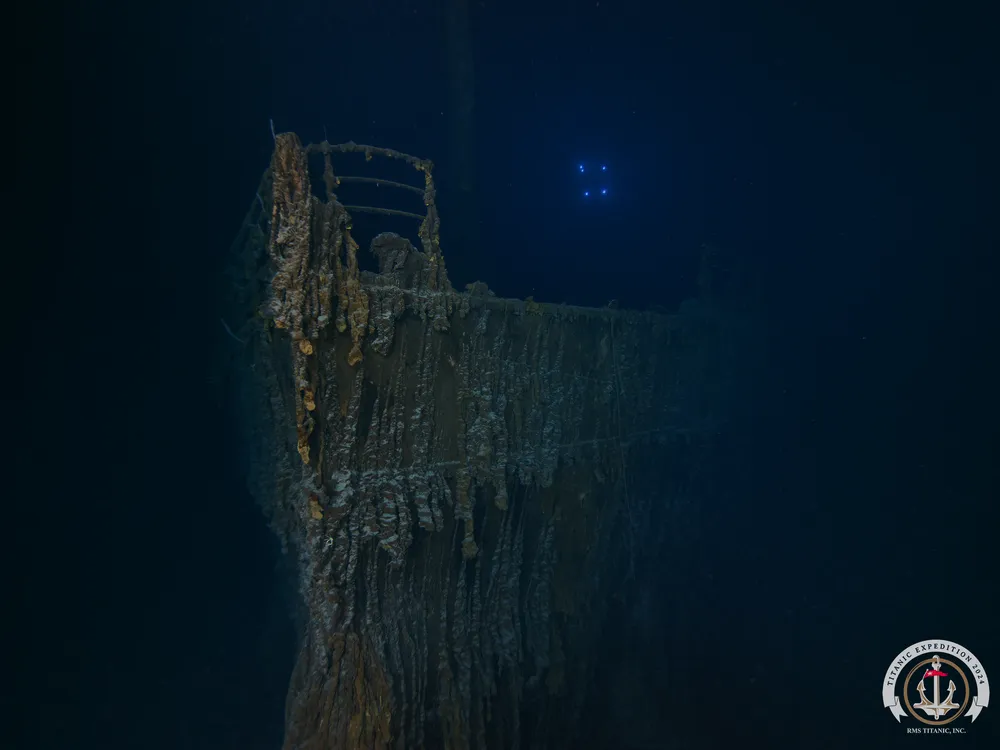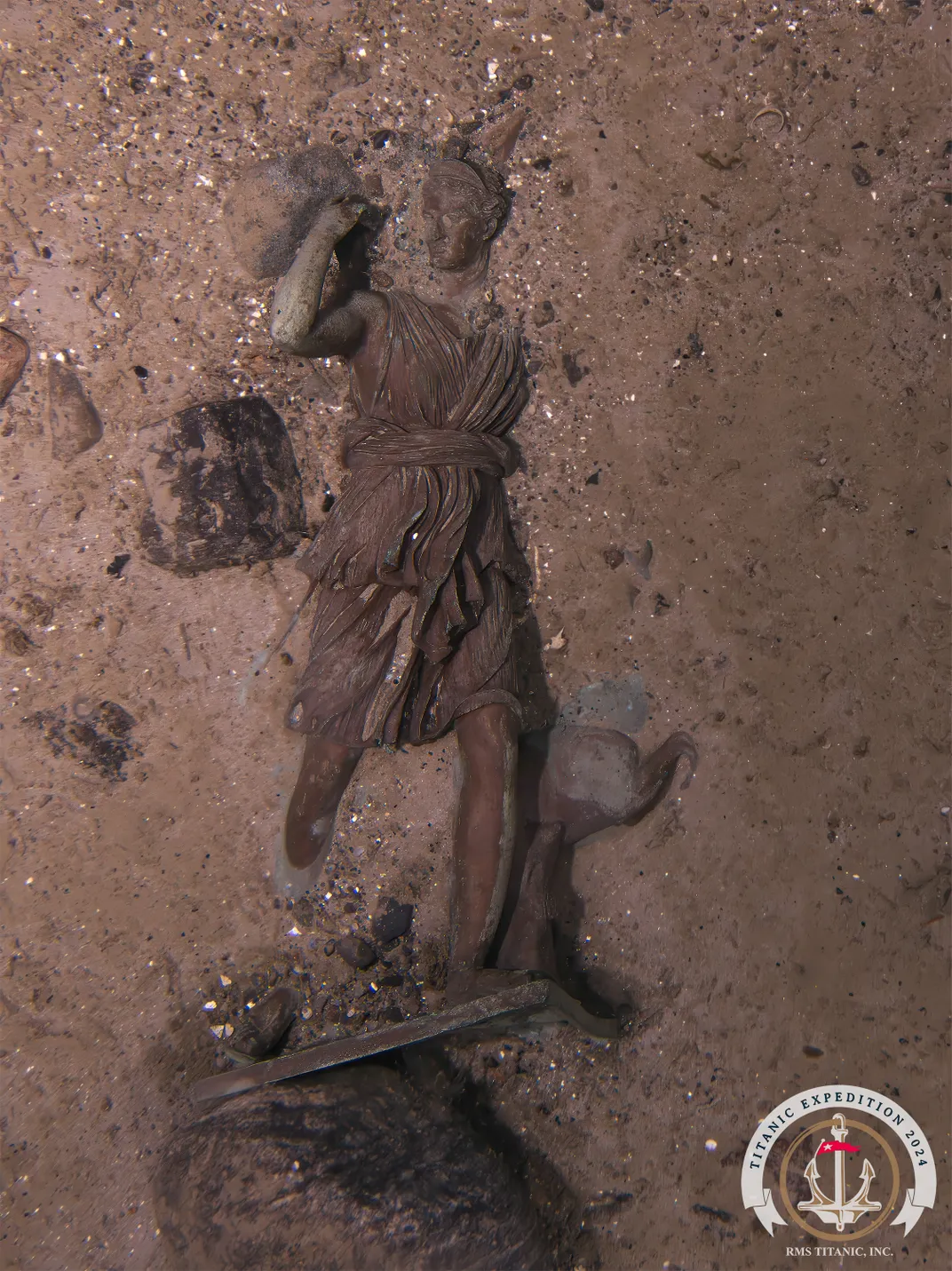New Photographs Reveal Decay of the Titanic and Collapse of Its Iconic Railing
An expedition this summer documented signs of deterioration on the wreck, but it also rediscovered the Diana of Versailles statue, the centerpiece of the ship’s first-class lounge

It’s arguably one of the most famous scenes in cinematic history: Leonardo DiCaprio guides Kate Winslet, her eyes closed, to the railing at the bow of the doomed Titanic. Winslet opens her eyes, looks out over the ocean and exclaims, “I’m flying, Jack!” Moments later, in the glow of the Titanic’s last sunset, they share their first kiss.
Now, an expedition to the wreckage of the Titanic by the company RMS Titanic Inc. has found that a roughly 15-foot section on the port side of the iconic bow railing depicted in that scene has collapsed and fallen to the ocean floor.
“This is a very natural thing, different parts of the railing are getting weaker,” RMS Titanic spokesperson and researcher James Penca tells NPR’s Scott Detrow. “But for such a high-profile and highly photographed and iconic railing to now be resting on the ocean floor below, it’s a significant change. Titanic will literally never look the same.”
RMS Titanic holds exclusive salvage rights to the wreckage of the ship and has conducted nine expeditions to the site since 1987. Their most recent expedition spanned 20 days beginning in July, returning to port in Providence, Rhode Island, on August 9. Researchers captured more than two million new photographs, recorded video and mapped the shipwreck and its field of debris.
On the company’s previous expedition in 2010, the railing was still standing. A full scan of the exterior of the ship completed in 2022 by a different diving outfit also observed the railing intact. But the new findings show that 112 years after the Titanic crashed into an iceberg and sank, killing about 1,500 of the 2,240 people aboard, even the sturdy metal of the ship is decaying.
One cause is tiny microbes that chow down on the ship’s metal and form ethereal-looking “rusticles” that hang like ice on a winter day. At the wreck site more than two miles beneath the surface of the Atlantic Ocean, bacteria are slowly causing vast deterioration to the vessel. Experts think these microbes—along with the effects of the salty seawater and the movement of deep-ocean currents—led to the railing’s collapse.
“It’s just another reminder of the deterioration that’s happening every day,” Tomasina Ray, director of collections at RMS Titanic, tells BBC News’ Rebecca Morelle and Alison Francis. “People ask all the time: ‘How long is Titanic going to be there?’ We just don’t know, but we’re watching it in real time.”
Even as the new visuals revealed the slow breakdown of the ship and its contents, the recent expedition also made an exciting discovery: Researchers found an iconic statue that had been lost for decades.
In 1986, a year after he initially discovered the Titanic’s wreckage, Robert Ballard photographed the statue, which formed the centerpiece on the fireplace mantle in the first-class lounge. Known as the Diana of Versailles, it is a two-foot-tall bronze replica of a larger version on display at the Louvre in Paris. But since then, its location remained unknown.
This year’s expedition found Diana again, 38 years later. “Following 112 years on the ocean floor and a brief sighting in 1986, she is still resting upright among miles of debris,” RMS Titanic says in an Instagram post. “Like the eternal Roman deities, she is timeless—and she is rediscovered.”

The company hopes to one day return to the wreck to retrieve items for preservation, including the Diana of Versailles statue, Penca tells BBC News. But in the past, RMS Titanic has faced backlash for removing about 5,500 artifacts from the shipwreck site, per the New York Times’ Sara Ruberg. And after OceanGate’s Titan submersible imploded last year, killing its five passengers, the U.S. government argued that RMS Titanic should get federal approval before recovering any objects from the site.
For the time being, a spokesman for RMS Titanic tells the New York Times that there are no official plans to bring back more artifacts. “The company is going through the data from this expedition to establish next steps,” he tells the publication.
Whether researchers plan to retrieve items or simply study them on-site, the new evidence demonstrates that teams will be racing the clock as the ship deteriorates.
“The discovery of the statue of Diana was an exciting moment,” Ray says in a statement. “But we are saddened by the loss of the iconic bow railing and other evidence of decay, which has only strengthened our commitment to preserving Titanic’s legacy.”

